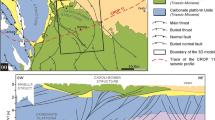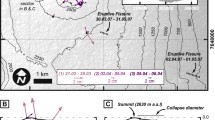This paper presents a forward model for subsidence prediction caused by extraction of hydrocarbons. The model uses combinations of analytic solutions to the visco-elastic equations, which approximate the boundary conditions. There are only a few unknown parameters to be estimated, and, consequently, calculations are very fast. The semi-analytic model is applicable to a uniform and layer-cake stratigraphy, with visco-elastic parameters changing per layer, and an arbitrary depletion pattern. By its capabilities to handle a multi-layered visco-elastic subsurface, the semi-analytic model fills the gap between the analytic single-layered elastic models available to date and the more elaborate numerical, e.g. finite element, models.
Similar content being viewed by others
References
Abate, J., and Valkó, P. P., 2004, Multi-precision Laplace transform inversion: Int. J. Num. Methods Eng., no. 60, p. 979–993.
Arfken, G., 1970, Mathematical Methods for Physicist: Academic Press, New York, 815 p.
Chin, L. Y., and Thomas, L. K., 1999, Fully coupled analysis of improved oil recovery by reservoir compaction, SPE paper 56753: Soc. Petrol. Eng. Ann. Tech. Conf. & Exhibition., Houston.
Crouch, S. L., and Starfield, A. M., 1983, Boundary Element Methods in Solid Mechanics: with Applications in Rock Mechanics and Geological Engineering: George Allen & Unwin, London, 322 p.
DIANA, 1999, Program and User's Manual, Release 7.1: TNO Building and Construction Research.
Doornhof, D., 1992, Surface subsidence in the Netherlands: The Groningen gas field: Geologie en Mijnbouw, no. 71, p. 119–130.
Fairweather, G., and Karageorghis, A., 1998, The method of fundamental solutions for elliptic boundary value problems: Adv. Comp. Math. v. 9, p. 69–95.
Fares, N., and Li, V. C., 1998, General image method in a plane-layered elastostatic medium: J. Appl. Mech., Trans. ASME v. 55, no. 110, p. 781–785.
Fitts, C. R., 1989, Simple analytic functions for modeling three-dimensional flow in layered aquifers: Water Resources Res., no. 25, p. 943–948.
Fokker, P. A., 1995, The Behaviour of Salt and Salt Caverns: unpubl. PhD thesis, Delft University of Technology, The Netherlands, 143 p.
Fokker, P. A., 2001, Semi-analytic subsidence prediction: Proc. Boundary Elements Conference XXIII, p. 117–126.
Fokker, P. A., Verga, F., and Egberts, P. J. P., 2005, New semi-analytic technique to determine horizontal well productivity in fractured reservoirs: Soc. Petrol. Eng. Reservoir Engineering, April issue, p. 123–131.
Fredrich, J. T., Deitrick, G. L., Arguello, J. G., and De Rouffignac, E. P., 1998, Reservoir compaction, surface subsidence, and casing damage: A geomechanics approach to mitigation and reservoir management, Soc. Petrol. Eng. paper 47284: EUROCK'98, v. 1, p. 403–412.
Geertsma, J., 1973, Land subsidence above compacting oil and gas reservoirs: J. Petrol. Technol., p. 734–744.
Houtenbos, A. P. E. M., 2000, The quantification of subsidence due to gas-extraction in The Netherlands: Proc., 6th Int. Symp. Land Subsidence, v. 1, p. 177.
Johnson, J. P., Rhett, D. W., and Siemers, W. T., 1989, Rock mechanics of the Ekofisk reservoir in the evaluation of subsidence: J. Petrol. Technol., July issue, p. 717–722.
Mayuga, M. N., and Allen, D. R., 1969, Subsidence in the Wilmington oil field, Long Beach, Calif., USA, in Tison, L. J., ed., Land subsidence, v. 1, no. 88: Internat. Assoc. Sci. Hydrology Publ., p. 6C6–79.
Mindlin, R. D., 1936, Force at a point in the interior of a semi-infinite solids: Physics, no. 7, p. 195–202.
Mindlin, R. D., and Cheng, D. H., 1950, Thermoelastic stress in the semi-infinite solid: J. Appl. Phys., no. 21, p. 931–933.
Morita, N., Whitfill, D. L., Nygaard, O., and Bale, A., 1989, A quick method to determine subsidence, reservoir compaction, and in-situ stress induced by reservoir depletion: J. Petrol. Technol., January issue, p. 71–79.
Nagel, N. B., 1998, Ekofisk field overburden modelling, Soc. Petrol. Eng. Paper 47345: EUROCK'98, v. 2, p. 177–186.
NAM report, 2000, Monitoring of the effects of subsidence on Ameland-East, unpublished (in Dutch).
Narayanan, G. V., and Beskos, D. E., 1982, Numerical operational methods for time-dependent linear problems: Int. J. Num. Methods Eng., no. 18, p. 1829–1854.
Opstal, G. H. C. van, 1974, The effect of base-rock rigidity on subsidence due to reservoir compaction: Proc 3rd Congr. Int. Soc. Rock Mech., v. 2, p. 1102–1111.
Ranalli, G., 1996, Rheology of the Earth: Chapman & Hall, London, 413 p.
Settari, A., and Walters, D. A., 2001, Advances in coupled geomechanical and reservoir modeling with applications to reservoir compaction: Soc. Petrol. Eng. J., September issue, p. 334–342.
Valkó, P. P., and Abate, J., 2004, Comparison of sequence accelerators for the Gaver method of numerical Laplace transform inversion: Comp. Math. Appl., no. 48, p. 629–636.
Author information
Authors and Affiliations
Corresponding author
Rights and permissions
About this article
Cite this article
Fokker, P.A., Orlic, B. Semi-Analytic Modelling of Subsidence. Math Geol 38, 565–589 (2006). https://doi.org/10.1007/s11004-006-9034-z
Published:
Issue Date:
DOI: https://doi.org/10.1007/s11004-006-9034-z




